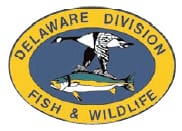Fungus Associated With White-Nose Syndrome Detected In Delaware Bats
No threat posed to humans, pets, livestock or property; Division of Fish and Wildlife continues to monitor Delaware bats for impacts from WNS.


Delaware –-(AmmoLand.com)- Delaware environmental officials have confirmed the fungus associated with White-nose Syndrome (WNS) on bats in two locations in New Castle County.
The disease is characterized by a white fungus on the noses, wings, tails and ears of bats. The fungus thrives in cold temperatures and is seen on bats in caves and mines in the northeast, Canada and, more recently, in Tennessee and Missouri.
Delaware does not have known hibernation sites suitable for the fungus to grow; therefore WNS has not been detected here in winter. Bats typically groom the fungus off when they leave their hibernation sites at the end of the winter, making it more difficult to detect in spring and summer. However, it may still be present and affect bats after they return to their maternity colony sites, which can be many miles from their winter homes.
The bats tested – new arrivals to their summer roost sites in Delaware – had wing and ear scarring consistent with WNS and tissue samples were sent to the National Wildlife Research Center for testing. Both samples came back positive for the fungus Geomyces destructans. These were the first bats examined and officials expect it to be common and widespread.
WNS poses no health threat to humans but has caused the death of over a million bats and has been detected from Canada to Tennessee to Missouri. Many researchers and cave visitors have been in contact with affected bats and caves and no humans have become ill from this disease. Although there will be no direct impact to human, pet or livestock health, the anticipated loss of large numbers of bats could have indirect impacts on humans. As the primary consumer of night flying insects, bats help control mosquito, beetle and moth (some of which are serious agricultural pests) populations.
Some of Delaware’s most common bat species, little brown, big brown and tri-colored bats are affected by WNS. Some less populous species, such as the small-footed and long-eared bats, are also at risk. Other bat species found in Delaware, such as the red bat, silver-haired, hoary and evening bats are less at risk because they do not typically overwinter in caves and mines where the fungus is doing most of its damage.
The presence of the WNS-associated fungus in Delaware does not come as a surprise to bat biologists because all of the state’s summer colonies of cave bats migrate here from other states with caves or mines and all of the states within migrating distance of Delaware have previously confirmed WNS.
Delaware officials will continue to search for bat colonies, monitor bats for signs of the disease and assess possible changes in population sizes.
We ask that the public:
- Report bat roost locations;
- Report dead bats or bats exhibiting unusual behavior, such as flying during the day;
- Do not touch bats. In addition to the possibility of the bat carrying rabies, there is concern that humans can speed the spread of WNS by unknowingly carrying the fungus from one location to another.
Individuals interested in helping can volunteer to track Delaware’s bat population. Please see http://www.fw.delaware.gov/bats for information on Delaware’s volunteer bat count project.
To report a bat colony or unusual bat behavior, please call 735-8651 or enter the information on-line at http://www.fw.delaware.gov/bats/ and scroll to link at bottom of page.
For more information, please call Holly Niederriter of Delaware Division of Fish & Wildlife, at 302-735-8651.
